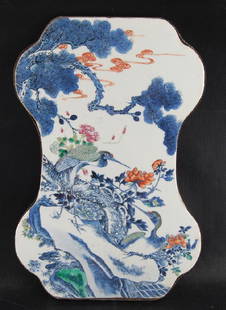
Frieze of wall tiles. VALENCIA (Manises or Gandia);
Similar Sale History
Recommended Items









Item Details
Description
Frieze of wall tiles.
VALENCIA (Manises or Gandia); late 15th – early 16th century.Portion of frieze comprising fourteen horizontal rectangles designed to be set two by two to form the pattern, and two bands of rectangles to close the composition's two long sides.
Majolica painted in blue and burnished gold lustre; in one of the rectangles, spots of green, possibly a result of dripping from another majolica during firing.
Front: decoration in relief. The recurrent decorative motif inside the frieze, which is obtained by joining two tiles, presents: four rosettes at the sides: a band with chevrons in two ribbed circles in the centre; an umbraculum in the centre; and a small cruciform mark – possibly the potter's signature – at the top of one of the tiles.
Back: unadorned; a black triangle made up of three fleur-de-lys is painted on the tile with a cruciform mark on the front.
In the vertical rectangles: polychrome braid.
Interpreting the emblems: umbraculum, a bishop's and cardinal's privilege and the emblem of the basilicas in Rome; three fleur-de-lys, emblem of the kings of France in honour of the Most Holy Trinity after 1376.
Each group of two tiles: 26.5 x 31 cm.; vertical rectangles: 9 x 4.5 cm. each. Condition: discrete; a few of the tiles still bear slight traces of where they were once glued to masonry.
Exhibitions: Rome, Biblioteca Casanatense, Monumental Hall, “Nymphilexis. Printed Manuscripts, Coins, Medals, Ceramicsâ€, Exhibition 7 April – 30 May 2005.
Bibliography: Gardelli 2005, pp. 302 - 303.This series of tiles belonged to a wall frieze, as we can tell from the complete absence of any sign of their ever having been trodden upon. The chevron decoration and the use of burnished gold lustre in relief are typical features of gilded ceramics manufactured in Valencia from the 15th to the 17th century and beyond. Yet the umbraculum in the centre of the decorative motif – a bishop's and cardinal's emblem but also a motif found on numerous Roman coats-of-arms – takes us to Rome, and more precisely to the pontificate of the Spanish Pope Alexander VI Borgia, a time when these majolicas, commissioned in Spain, were the height of fashion, An important clue in helping us to identify the frieze's original setting is undoubtedly the motif with three fleurs-de-lys impressed on the back of one of them. The three fleus-de-lys, the emblem of the royal house of France, point to the construction of the French church of Trinità dei Monti, begun by Louis XII in 1502 and completed in 1519. It is highly likely that the frieze, commissioned in Manises or Gandia where the best lustre majolica was manufactured, originally formed part of the building's interior decoration.
VALENCIA (Manises or Gandia); late 15th – early 16th century.Portion of frieze comprising fourteen horizontal rectangles designed to be set two by two to form the pattern, and two bands of rectangles to close the composition's two long sides.
Majolica painted in blue and burnished gold lustre; in one of the rectangles, spots of green, possibly a result of dripping from another majolica during firing.
Front: decoration in relief. The recurrent decorative motif inside the frieze, which is obtained by joining two tiles, presents: four rosettes at the sides: a band with chevrons in two ribbed circles in the centre; an umbraculum in the centre; and a small cruciform mark – possibly the potter's signature – at the top of one of the tiles.
Back: unadorned; a black triangle made up of three fleur-de-lys is painted on the tile with a cruciform mark on the front.
In the vertical rectangles: polychrome braid.
Interpreting the emblems: umbraculum, a bishop's and cardinal's privilege and the emblem of the basilicas in Rome; three fleur-de-lys, emblem of the kings of France in honour of the Most Holy Trinity after 1376.
Each group of two tiles: 26.5 x 31 cm.; vertical rectangles: 9 x 4.5 cm. each. Condition: discrete; a few of the tiles still bear slight traces of where they were once glued to masonry.
Exhibitions: Rome, Biblioteca Casanatense, Monumental Hall, “Nymphilexis. Printed Manuscripts, Coins, Medals, Ceramicsâ€, Exhibition 7 April – 30 May 2005.
Bibliography: Gardelli 2005, pp. 302 - 303.This series of tiles belonged to a wall frieze, as we can tell from the complete absence of any sign of their ever having been trodden upon. The chevron decoration and the use of burnished gold lustre in relief are typical features of gilded ceramics manufactured in Valencia from the 15th to the 17th century and beyond. Yet the umbraculum in the centre of the decorative motif – a bishop's and cardinal's emblem but also a motif found on numerous Roman coats-of-arms – takes us to Rome, and more precisely to the pontificate of the Spanish Pope Alexander VI Borgia, a time when these majolicas, commissioned in Spain, were the height of fashion, An important clue in helping us to identify the frieze's original setting is undoubtedly the motif with three fleurs-de-lys impressed on the back of one of them. The three fleus-de-lys, the emblem of the royal house of France, point to the construction of the French church of Trinità dei Monti, begun by Louis XII in 1502 and completed in 1519. It is highly likely that the frieze, commissioned in Manises or Gandia where the best lustre majolica was manufactured, originally formed part of the building's interior decoration.
Buyer's Premium
- 25%
Frieze of wall tiles. VALENCIA (Manises or Gandia);
Estimate €18,000 - €20,000
2 bidders are watching this item.
Get approved to bid.
Shipping & Pickup Options
Item located in Rome, itSee Policy for Shipping
Payment

Related Searches
TOP

























![Modern Mosaic Tile Wall Console: Iron wall console with an abstract image of yellow, blue and brown individual tiles. [12" H x 55" L]. In good condition.](https://p1.liveauctioneers.com/1221/87252/44803363_1_x.jpg?height=310&quality=70&version=1459976488)





















